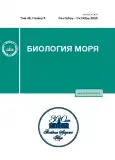Mycotoxins in Macroalgae from the Kandalaksha Gulf of the White Sea after Natural and Experimental Alienation from the Substrate
- Autores: Burkin A.A.1, Kononenko G.P.1
-
Afiliações:
- Skryabin and Kovalenko All-Russian Research Institute of Experimental Veterinary Medicine Federal Scientific Center, Russian Academy of Sciences
- Edição: Volume 49, Nº 5 (2023)
- Páginas: 287-292
- Seção: ОРИГИНАЛЬНЫЕ СТАТЬИ
- ##submission.datePublished##: 01.09.2023
- URL: https://journals.rcsi.science/0134-3475/article/view/140785
- DOI: https://doi.org/10.31857/S0134347523050054
- EDN: https://elibrary.ru/EOMHDR
- ID: 140785
Citar
Texto integral
Resumo
Samples of macrophyte algae were collected from an ecotope of Kandalaksha Gulf, the White Sea. These algae were selected from substrates, storm wracks and after long-term storage in the soil, and they were assessed by indirect competitive enzyme immunoassay for the presence of low-molecular metabolites of micromycetes (mycotoxins). In Fucus distichus, F. serratus, F. vesiculosus, and Ascophyllum nodosum, the concentrations of all analyzed toxic substances from storm wracks were uniformly reduced compared to those in living thalli. For Laminaria digitata, Saccharina latissima and Ahnfeltia plicata, in living individuals of which mycotoxins were not found or were extremely rare, cases of contamination with citrinin, mycophenolic acid, emodin and sterigmatocystin were found in storm wracks. After 12 months of burial in soil F. distichus samples had only 9 components out of 16 analyzed. In F. serratus, F. vesiculosus, A. nodosum, and Pelvetia canaliculata, only emodin, mycophenolic acid, alternariol, and ergot alkaloids were determined.
Palavras-chave
Sobre autores
A. Burkin
Skryabin and Kovalenko All-Russian Research Institute of Experimental Veterinary Medicine Federal Scientific Center, Russian Academy of Sciences
Email: kononenkogp@mail.ru
Russia, 123022 , Moscow
G. Kononenko
Skryabin and Kovalenko All-Russian Research Institute of Experimental Veterinary Medicine Federal Scientific Center, Russian Academy of Sciences
Autor responsável pela correspondência
Email: kononenkogp@mail.ru
Russia, 123022 , Moscow
Bibliografia
- Бубнова Е.Н. Новые для Белого моря виды морских грибов // Вестн. Моск. ун-та. Сер. 16. Биология. 2016. № 4. С. 41–44.
- Бубнова Е.Н., Грум-Гржимайло О.А., Коновалова О.П., Марфенина О.Е. 50 лет микологических исследований на Беломорской биостанции им. Н.А. Перцова: основные направления, итоги, перспективы // Вестн. Моск. ун-та. Сер. 16. Биология. 2014. № 1. С. 29–46.
- Бубнова Е.Н., Киреев Я.В. Сообщества грибов на талломах бурых водорослей рода Fucus в Кандалакшском заливе Белого моря // Микол. фитопатол. 2009. Т. 43. Вып. 5. С. 388–397.
- Буркин А.А., Кононенко Г.П. Феномен смещения профиля токсинов микромицетов в бурых водорослях из штормовых выбросов. Тезисы докладов Всероссийской конференции “Биология водных экосистем в XXI веке: факты, гипотезы, тенденции”, Борок, 22–26 ноября 2021 г. – Ярославль: Филигрань. 2021. С. 32.
- Буркин А.А., Кононенко Г.П., Георгиев А.А., Георгиева М.Л. Особенности накопления микотоксинов в макрофитах Белого моря // Современная микология в России. 2020. Т. 8. С. 100–102.
- Буркин А.А., Кононенко Г.П., Георгиев А.А., Георгиева М.Л. Токсичные метаболиты микромицетов в бурых водорослях семейств Fucaceae и Laminariaceae из Белого моря // Биол. моря. 2021. Т. 47. № 1. С. 40–44.
- Возжинская В.Б. Изучение экологии и распределения водорослей в Кандалакшском заливе Белого моря // Океанология. 1967. Вып. 6. С. 1108–1118.
- Коваленко М.И., Бубнова Е.Н., Георгиева М.Л. Грибы, ассоциированные с красной водорослью Palmaria palmata (L.) F. Weber & D. Mohr, на примере Кандалакшского залива Белого моря // Труды VIII Международной научно-практической конференции “Морские исследования и образование (MARESEDU–2019)”, Т. 2 (3): [сборник]. Тверь: ПолиПРЕСС. 2020. С. 440–443.
- Коновалова О.П., Бубнова Е.Н. Грибы на бурых водорослях Ascophyllum nodosum и Pelvetia canaliculata в Кандалакшском заливе Белого моря // Микол. фитопатол. 2011. Т. 45. Вып. 3. С. 240–248.
- Кононенко Г.П., Буркин А.А., Георгиев А.А., Георгиева М.Л. Микотоксины в макроводорослях из пролива Великая Салма Кандалакшского залива Белого моря // Биол. моря. 2022. Т. 48. № 1. С. 53–61.
- Максимова О.В., Мюге Н.С. Новые для Белого моря формы фукоидов (Fucales, Phaeophyceae): морфология, экология, происхождение // Ботан. журн. 2007. Т. 92. № 7. С. 965–986.
- Човган О.В., Малавенда С.С. Роль макрофитов как субстрата в формировании литоральных эпизооценозов Белого моря // Вест. Мурман. гос. техн. ун-та. 2017. Т. 20. № 2. С. 390–400.
- Bakutis B., Baliukoniené V., Paškevičius A. Use of biological method for detoxification of mycotoxins // Botanica Lithuanica. 2005. Suppl. 7. P. 123–129.
- Christiansen J.V., Isbrandt T., Petersen C. et al. Fungal quinones: diversity, producers, and application of quinones from Aspergillus, Penicillium, Talaromyces, Fusarium, and Arthrinium // Appl. Microbiol. Biotechnol. 2021. V. 105. P. 8157–8193.
- Hathout A.S., Aly S.E. Biological detoxification of mycotoxins: A review // Ann. Microbiol. 2014. V. 64. № 3. P. 905–919.
- He C., Fan Y., Liu G., Zhang H. Isolation and identification of a strain of Aspergillus tubingensis with deoxynivalenol biotransformation capability // Int. J. Mol. Sci. 2008. № 9. P. 2366–2375.
- Ji C., Fan Y., Zhao L. Review on biological degradation of mycotoxins // Animal Nutrition. 2016. № 2. P. 127–133.
- Taheur F.B., Kouidhi B., Al Qurashi Y.M.A. et al. Review: Biotechnology of mycotoxin detoxication using microorganisms and enzymes // Toxicon. 2019. V. 160. P. 12–22.
- Verhoet H.A. Litter bag method // Methods in Applied Soil Microbiology and Biochemistry. Waltham: Academic Press. 1995. P. 485–487.
- Wilson N.M., McMaster N., Gantulga D. et al. Modification of the mycotoxin deoxynivalenol using microorganisms isolated from environmental samples // Toxins. 2017. V. 9. P. 141.
- Xin Z.-H., Wang W.-L., Zhang Y.-P. et al. Pennicitrinone D, a new citrinin dimer from the halotolerant fungus Pe-nicillium notatum B-52 // J. Antibiotics. 2009. V. 62. P. 225–227.
Arquivos suplementares









